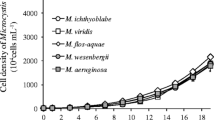Abstract
A Myxococcus xanthus isolate from a farm drainage ditch, designated strain PCO2, is capable of rapidly inducing lysis of both agar and liquid-grown cultures of the cyanobacterium, Phormidium luridum, var. olivacea. Microscopic studies of the predator-prey interaction demonstrate that lysis of the cyanobacterium occurs within clumps and spherules formed by the cells of M. xanthus PCO2. In the earliest stage, one sees the formation of irregular microclumps of bacteria and cyanobacterial filaments. As these clumps mature, colonies 1 to 6 mm in diameter develops. The center of these densely green colonies contains cyanohacteria in various stages of degradation, while the periphery is almost exclusively a tightly woven mass of myxobacterial cells. Electron microscopy shows that long extrusions from the outer membrane of the M. xanthus PCO2 cells are involved in the formation both of initial clumps and of mature colonial spherules. These extrusions appear to efficiently entangle the cyanobacterial filaments in the culture environment. Predator-to-prey ratios of 1/10, 1/100 and 1/1,000 have resulted in cyanobacterial lysis. Because the entrapment and lysis of P. luridum filaments by M. xanthus PCO2 appears to be independent of any other heterotrophic nutritional requirement, as well as of environmental agitation, this system has potential as a biological control technique for undesirable aquatic cyanobacteria.
Similar content being viewed by others
Abbreviations
- TEM:
-
transmission electron microscopy
- SEM:
-
scanning electron microscopy
- AB:
-
algae broth
- ABT:
-
algae broth plus 0.2% tryptone
References
Beebe JM (1941) Studies on the myxobacteria. 2. The role of myxobacteria as bacterial parasites. Iowa State J sci 15:319–337
Burchard R (1975) Myxospore induction in a nondispersed growing mutant of Myxococcus xanthus. J Bacteriol 122:301–306
Burnham JC, Collart SA, Highison BW (1980) Myxobacterial antagonism for Phormidium luridum. Abs Ann Mtg Am Soc Microbiol 1b
Burnham JC, Hashimoto T, Conti SF (1968) Electron microscopic observations on the penetration of Bdellovibrio bacteriovorus into gram-negative bacterial hosts. J Bacteriol 96:1366–1381
Burnham JC, Stetak T, Boulger J (1973) An improved method of cell enumeration for filamentous algae and bacteria. J Phycol 9:346–349
Burmham JC, Stetak T, Locher G (1976) Extracellular lysis of the bluegreen alga, Phormidium luridum by Bdellovibrio bacteriovorus. J Phycol 12:306–313
Christensen PJ (1977) The history, biology and taxonomy of the Cytophaga group. Can J Microbiol 23:1599–1653
Christensen P, Cook FD (1978) Lysobacter, a new genus of nonfruiting, gliding bacteria with a high base ratio. Int J Syst Bacteriol 28:367–393
Daft MJ, McCord SB, Stewart WDP (1975) Ecological studies on algalysing bacteria in fresh waters. Freshwat Biol 5:577–596
Daft MJ, Stewart WDP (1971) Bacterial pathogens of freshwater bluegreen algae. New Phytol 70:819–829
Daft MJ, Stewart WDP (1973) Light and electron microscope observations on algal lysis by bacterium CP-1. New Phytol 72:799–808
Dobson WJ, McCurdy HD (1979) The function of fimbriae in Myxococcus xanthus. I. Purification and properties of M. xanthus fimbriae. Can J Microbiol 25:1152–2260
Dworkin M (1972) The myxobacteria: new directions in studies of procaryotic development. Crit Rev Microbiol 2:435–452
Dworkin M (1973) Cell-cell interactions in the myxobacteria. In: Ashworth JM, Smith JE (eds) Microbial differentiation. 23rd Symp Soc Gen Microbiol, Cambridge Univ Press, London, pp 125–142
Dworkin M, Gibson SM (1964) A system for studying microbial morphogenesis: rapid formation of microcysts in Myxococcus xanthus.Science 146:243–244
Ensign JC, Wolfe RS (1965) Lysis of bacterial cell walls by an enzyme isolated from a myxobacter. J Bacteriol 90:395–402
Gnosspelius G (1978) Purification and properties of an extracellular protease from Myxococcus virescens. J Bacteriol 133:17–25
Haska G (1974) Extracellular lytic enzymes of Myxococcus virescens. IV. Purification and characterization of a d-alanyl-e-N-lysine and endopeptidase. Physiol Plant 31:252–256
Hayat MA (1978) Introduction to biological scanning electron microscopy. Univ Park Press, Baltimore
Hodgkin J, Kaiser D (1977) Cell-to-cell stimulation of movement in nonmotile mutants of Myxococcus. Proc Natl Acad Sci USA 74:2938–2942
Kaiser D, Manoil C, Dworkin J (1979) Myxobacteria: cell interactions, genetics and development. Ann Rev Microbiol 33:595–639
Lang NJ (1968) The fine structure of the blue-green algae. Ann Rev Microbiol 22:15–46
Rosenberg E, Vaks B, Zuckerberg A (1973) Bactericidal actions of an antibiotic produced by Myxococcus xanthus. Antimicrob. Agents Chemother. 4:507–513
Rosenberg E, Keller KH, Dworkin M (1977) Cell density-dependent growth of Myxococcus xanthus on casein. J Bacteriol 129:770–777
Schürmann C (1967) Growth of myxococci in suspension in liquid media. Appl Microbiol 15:971–974
Shilo M (1967) Formation and mode of action of algal toxins. Bacteriol Rev 31:180–193
Shilo M (1970) Lysis of bluegreen algae by Myxobacter. J Bacteriol 104:453–461
Stewart JR, Brown RM (1969) Cytophaga that kills or lyses algae. Science 164:1523–1524
Stewart JR, Brown RM (1971) Aligcidal non-fruiting myxobacteria with high G+C ratios. Arch Mikrobiol 80:177–190
Sudo S, Dworkin M (1972) Bacteriolytic enzymes produced by Myxococcus xanthus. J Bacteriol 110:236–245
Wu B, Hardy MK, Howe HB (1968) Antimicrobial activity of a myxobacterium against bluegreen algae. Bacteriol Proc p 48
Zahler SA, McCurdy HO (1974) Myxococcaceae. In: Buchanan RE, Gibbons NE (eds) Bergey's manual of determinative bacteriology, 8th ed. Williams and Wilkins Co., Baltimore, pp. 79–83
Author information
Authors and Affiliations
Rights and permissions
About this article
Cite this article
Burnham, J.C., Collart, S.A. & Highison, B.W. Entrapment and lysis of the cyanobacterium Phormidium luridum by aqueous colonies of Myxococcus xanthus PCO2. Arch. Microbiol. 129, 285–294 (1981). https://doi.org/10.1007/BF00414699
Received:
Accepted:
Issue Date:
DOI: https://doi.org/10.1007/BF00414699




